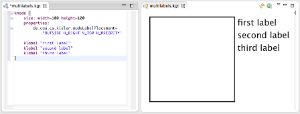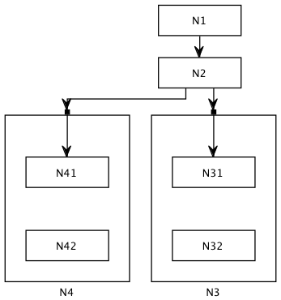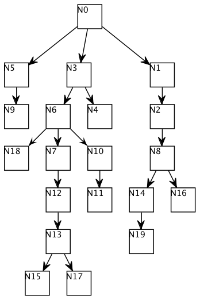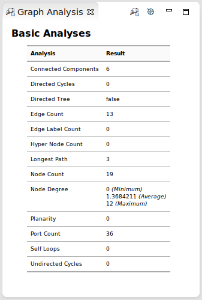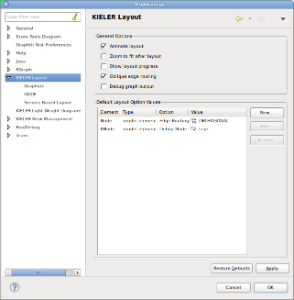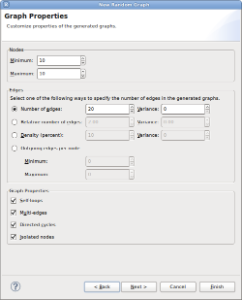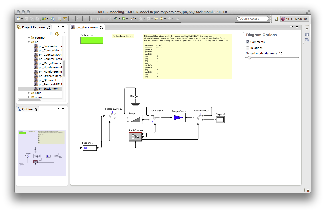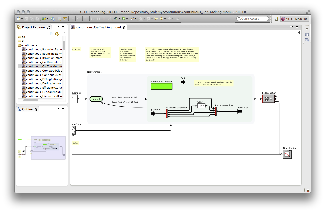Page History
KIELER Pragmatics 0.9.
...
1
- Official Project Website
- Built on Eclipse 4.2 "Juno"
We are happy to provide the eighth release of the Kiel Integrated Environment for Layout Eclipse Rich Client0.9.1 of the KIELER Pragmatics Project! It is a framework for enhanced user interaction in graphical modeling basing on the Eclipse platform. This being a pre-release it provides some basic core contributions as listed below. The full user experience will follow in upcoming releases. For known shortcomings and problems also see below.document describes how to install the release and highlights the most exciting new features.
| Info | ||
|---|---|---|
| ||
We have found that some dependency definitions in release 0.9.0 were incorrect. Release 0.9.1 corrects these problems, but does not add any features or fix any other bugs. |
| Table of Contents | ||
|---|---|---|
|
Installation
You can either download the Rich Client Application (RCA) which is a self-contained application bundled with everything you need to run KIELER, or you can install the single KIELER features via an update site on top of your own Eclipse installation (Eclipse KIELER Pragmatics 0.9.1 is provided as a set of features, available to be added to your Eclipse installation via an update site. KIELER Pragmatics 0.9.0 was tested on Eclipse 4.2 "Juno" required), but may also be compatible with other versions of Eclipse.
- See the KIELER Downloads site for download details.
- You'll require a KIELER Pragmatics requires an installed Java Runtime Environment >= version 1.5.
- Nice graph layouts can be obtained by GraphViz. KIELER makes use of a GraphViz installation on your machine, so you probably want to install itThe layout components of KIELER can make use of the layout algorithms provided by the GraphViz library. You may want to install that.
Release Notes
The Release 0.89.0 release is mainly a service release intended to provide proper support for Eclipse Juno 4.2 and to fix problems found in previous versionsmarks the first time that KIELER is not released in one complete package, but in separate packages: KIELER Pragmatics and KIELER Semantics. The releases are not synchronized; usually, the Semantics project will provide a release based on the latest Pragmatics code some time after the latest Pragmatics release.
The 0.9.0 release of KIELER Pragmatics adds major new features, but also marks the removal of old legacy code. You can find a complete list of solved tickets for this release at our issue tracking system. Release notes of older releases can be found at our Release Notes page.
New Features Included in 0.
...
9.
...
1
Here's a list of the most prominent new features provided with version 0.89.0:
...
- The buttons placed in the toolbar were replaced by a single button through which KIVI combinations can be reached.
...
- The algorithm now supports the placement of edge labels.
- The algorithm also supports the placement of node labels and proper resizing of nodes.
- Several improvements to the polyline edge routing algorithm.
...
- Support: Entry-/During-/Exit-Actions, Pre-Operator, History Transitions, Count Delays, embedded C-Hostcode (and C-Variable interactions)
- Visual Debgugging possibility
- Benchmark possibility
...
1:
- KIELER Light-Weight Diagrams
- Direct visualization of KGraphs specified using the new KGraph Text language.
- Direct visualization of KGraphs specified using the new KGraph Text language.
- KIELER Layout Algorithms
- Enhanced support for port labels and hierarchical ports in KLay Layered, including proper support for layout directions other than Right.
- Support for multiple node labels in KLay Layered. The labels share the same node label placement and are stacked above each other.
- New tree layout algorithm: KLay Mr. Tree.
- Enhanced support for port labels and hierarchical ports in KLay Layered, including proper support for layout directions other than Right.
- KIELER Infrastructure for Meta-Layout
- The Graph Analysis View now provides a way to select the analyses to be displayed. The analysis results are also more pleasing to look at.
- Usability improvements to preference pages.
- The Random Graph Wizard has received a major overhaul, including new features and cleaned-up user interface.
- The Graph Analysis View now provides a way to select the analyses to be displayed. The analysis results are also more pleasing to look at.
- KIELER Ptolemy Viewer
- Using the Ptolemy Viewer feature, Ptolemy
.momlfiles can be directly opened in Eclipse. This feature obsoletes the old Ptolemy Import Wizard. - Support for the visualization of modal models and for looking inside states with refinements.
- Using the Ptolemy Viewer feature, Ptolemy
Deprecated Features Removed in 0.
...
9.
...
1
The following features were shipping with version 0.78.0, but are not included in version 0.89.0 1 anymore:
- The Export Examples Wizard was removed.
Quickstart
Start with an Example
The 0.8.0 release provides examples you can add and play around with. You can start with an example by doing one of the following things:
- Select "Samples" on the Welcome page and select one of the provided examples. This will create a new project with the chosen example and open it in an editor.
- Use the New Wizard or the Import Wizard to select examples from a list of available ones:
- File -> New -> Example -> KIELER
- Choose a category (e.g. SyncCharts or KAOM) and select some examples
- Finish
Start with an Empty Workspace
When you start KIELER, you will probably start a new empty workspace.
- If it is not already there, open the KIELER Perspective! It opens the most important views that KIELER adds to Eclipse and adds some shortcuts to the New menu.
- Window -> Open Perspective -> Other... -> KIELER Modeling
- Create a new empty simple project.
- File -> New -> Project
In your new project you can create new graphical or textual models. Here is some possible use case:
- Create a new SyncCharts diagram.
- File -> New... -> SyncCharts Diagram
- Create a new initial SyncChart
- Select empty canvas -> KIELER main menu -> Add Default
- Edit the diagram
- Select existing graphical objects in the diagram, choose editing operations from the KIELER main menu or the context menu (right-click). You won't need the palette. Layout is always performed automatically.
- Trigger automatic layout
- Use the corresponding little button in the toolbar (or Ctrl-R L)
- Use the Layout view to customize the automatic layout: choose different layout algorithms---even within the same diagram for different hierarchical nodes---or configure specific options.
- Save the SyncChart to automatically validate it.
- Simulate the SyncChart with the Execution Managerview
- From the dropdown list select the matching schedule synccharts. This will setup KIEM for SyncCharts Simulation.
- Press the play button.
- Use the Execution Manager view and the Data Table view to interact with the model (i.e. see outputs and enter inputs).
- Checkout the key-bindings! Key-bindings help you to be faster with KIELER. All KIELER bindings have the Sequence Ctrl+R <key>, where <key> is some additional key that is pressed in sequence with Ctrl+R (CMD+R on Mac).
- Press only Ctrl+R and wait to get a list shown with all possible key-bindings.
- Maybe most frequently used are Ctrl+R L for autolayout and Ctrl+R Z for zoom to fit.
Known Problems and Limitations
- If KIELER fails to start with an error message such as "Failed to load the JNI shared library...", you might have downloaded KIELER 64bit even though you're running Java 32bit, or vice versa. This is a known Eclipse problem and can be fixed by downloading the proper version of KIELER. Note that if you have installed multiple versions of the JVM on your machine, you have to make sure that Eclipse (resp. KIELER RCA) finds the right one. You can achieve this either by adding the Java bin directory to your
PATHvariable or by specifying the path to your JVM executable in your eclipse.ini file, using the -vm option, as explained on this page. - The performance of SyncCharts simulation visualization with focus & context is rather bad on some platforms. This may cause problems when the step size is set to a small value (< 500 ms). Please deactivate the SyncCharts visualization component if you wish a faster simulationKEG Editor was removed. Its main use case (testing layout algorithms) is now covered by the KGraph Text Editor and KLighD. A reduced version of KEG is still available in the
plugins-devdirectory of our Git repository. - The KAOM project was removed.
- The KARMA project was moved to the semantics repository, since it is only used by the deprecated KEG and KAOM projects and the SyncCharts editor.
- The Ptolemy Import Wizard and the corresponding KAOM-based visualization was removed. Ptolemy
.momlfiles can now be directly opened. - The Graph Analysis dialog was removed and is replaced by the Graph Analysis View.
- Some core plugins were eliminated (they are still available in the Semantics repository):
- de.cau.cs.kieler.core.annotations
- de.cau.cs.kieler.core.annotations.edit
- de.cau.cs.kieler.core.annotations.text
- de.cau.cs.kieler.core.annotations.text.ui
- de.cau.cs.kieler.core.model
- de.cau.cs.kieler.core.model.gmf
- de.cau.cs.kieler.core.model.graphiti
- de.cau.cs.kieler.core.model.xtend
- de.cau.cs.kieler.core.model.xtext
Quickstart
Diagram Layout
One of the core features of KIELER Pragmatics is the KIELER Infrastructure for Meta-Layout (KIML). It provides the glue between diagram editors and layout algorithms. If you have installed layout support for GMF editors, you may want to try the following:
- Open a diagram using a GMF editor.
- Press the Layout button in the toolbar:
- Open the Layout View by clicking Window -> Show View -> Other... and choosing Layout from the KIELER Layout category.
- Change some of the values and press the Layout button again.
Viewing Ptolemy Models
If you have a Ptolemy installation, try the following:
- Save a Ptolemy model as a
.momlfile somewhere. - Import that file into an Eclipse project.
- Open the file with the Ptolemy Model Viewer.
- Double-click actors that have further models inside them. Also double-click modal model states that have refinements.
Known Problems and Limitations
- The Layout Hierarchy option of KLay Layered does not work with center labels of edges that cross hierarchy boundaries. There may also be further problems.
- The Ptolemy Model Viewer only supports a limited set of actors.
- Currently there is no full-blown user documentation integrated. See our KIELER for more information.
Bug Reports, Comments
We're working hard to make the graphical modeling user experience as convenient as possible. However, bugs can still remain in the code and some things might not be as you would expect them. Please don't hesitate to send in bug reports or give other comments like feature requests.
...
